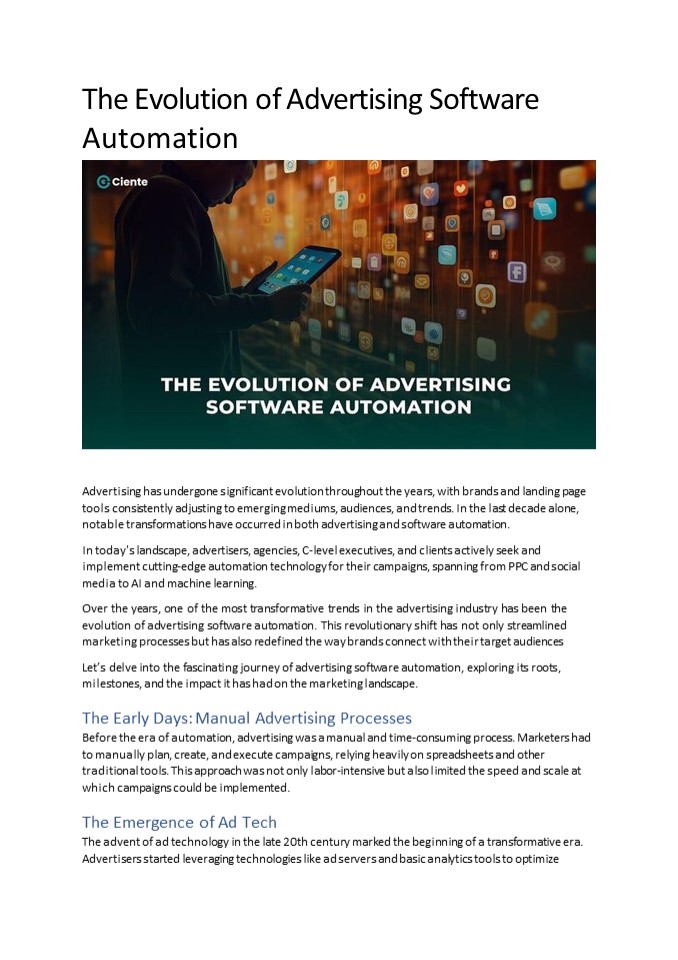The Evolution of Advertising Software Automation - PowerPoint PPT Presentation
Title:
The Evolution of Advertising Software Automation
Description:
Advertising has undergone significant evolution throughout the years, with brands and landing page tools consistently adjusting to emerging mediums, audiences, and trends. – PowerPoint PPT presentation
Number of Views:1
Date added: 2 February 2024
Slides: 4
Provided by:
Team_ciente
Category:
Medicine, Science & Technology
Tags:
Title: The Evolution of Advertising Software Automation
1
The Evolution of Advertising Software Automation
Advertising has undergone significant evolution
throughout the years, with brands and landing
page tools consistently adjusting to emerging
mediums, audiences, and trends. In the last
decade alone, notable transformations have
occurred in both advertising and software
automation. In today's landscape, advertisers,
agencies, C-level executives, and clients
actively seek and implement cutting-edge
automation technology for their campaigns,
spanning from PPC and social media to AI and
machine learning. Over the years, one of the most
transformative trends in the advertising industry
has been the evolution of advertising software
automation. This revolutionary shift has not only
streamlined marketing processes but has also
redefined the way brands connect with their
target audiences Lets delve into the fascinating
journey of advertising software automation,
exploring its roots, milestones, and the impact
it has had on the marketing landscape. The Early
Days Manual Advertising Processes Before the era
of automation, advertising was a manual and
time-consuming process. Marketers had to manually
plan, create, and execute campaigns, relying
heavily on spreadsheets and other traditional
tools. This approach was not only labor-intensive
but also limited the speed and scale at which
campaigns could be implemented. The Emergence of
Ad Tech The advent of ad technology in the late
20th century marked the beginning of a
transformative era. Advertisers started
leveraging technologies like ad servers and basic
analytics tools to optimize
2
campaign performance. While these advancements
improved efficiency to some extent, they were
still a far cry from the level of automation we
see today. Programmatic Advertising A
Game-Changer The real breakthrough came with the
rise of programmatic advertising in the early
2010s. Programmatic advertising relies on
algorithms and automated processes to buy and
optimize digital ad placements in real time. This
shift from manual to automated ad buying
revolutionized the industry, allowing advertisers
to target specific audiences with unparalleled
precision. Machine Learning and Artificial
Intelligence As technology continued to advance,
machine learning (ML) and artificial intelligence
(AI) became integral components of advertising
automation. These technologies enabled algorithms
to learn from data, optimizing campaigns based on
user behavior, demographics, and other relevant
factors. This level of sophistication allowed for
highly personalized and targeted advertising,
maximizing the impact of each campaign. Cross-Ch
annel Integration Another significant evolution
in advertising automation is the integration of
cross-channel capabilities. Modern advertising
platforms offer seamless coordination across
various channels such as social media, search
engines, and display networks. This cross-channel
integration ensures a consistent and cohesive
brand message, enhancing the overall
effectiveness of marketing campaigns. The Role
of Data in Automation Data has become the
lifeblood of advertising automation. The
abundance of data generated by online activities
allows marketers to make informed decisions and
optimize campaigns in real time. Data-driven
insights enable advertisers to understand
audience behavior, preferences, and trends,
facilitating the creation of highly relevant and
engaging advertisements. Challenges and Ethical
Considerations While the evolution of advertising
software automation has brought about numerous
benefits, it has also presented challenges and
ethical considerations. Issues related to data
privacy, ad fraud, and algorithmic bias have
become crucial points of discussion. As the
industry continues to progress, addressing these
challenges will be essential to ensure a
responsible and sustainable future for
advertising automation.
3
Conclusion The journey of advertising software
automation from manual processes to
sophisticated, data- driven, and AI-powered
campaigns has been nothing short of remarkable.
This evolution has not only increased efficiency
and accuracy but has also reshaped the way brands
communicate with their audiences. As we move
forward, it's clear that the future of
advertising lies in continued innovation, ethical
considerations, and a commitment to delivering
meaningful and personalized experiences to
consumers. AUTHOURS BIO With Ciente, business
leaders stay abreast of tech news and market
insights that help them level up now,
Technology spending is increasing, but so is
buyers remorse. We are here to change
that. Founded on truth, accuracy, and tech
prowess, Ciente is your go-to periodical for
effective decision-making.
Our comprehensive editorial coverage, market
analysis, and tech insights empower you to make
smarter decisions to fuel growth and innovation
across your enterprise.
Let us help you navigate the rapidly evolving
world of technology and turn it to your advantage.































